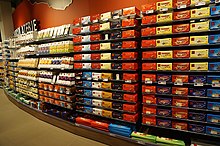
A chocolate bar is a confection containing chocolate, which may also contain layerings or mixtures that include nuts, fruit, caramel, nougat, and wafers. A flat, easily breakable, chocolate bar is also called a tablet. In some varieties of English and food labeling standards, the term chocolate bar is reserved for bars of solid chocolate, with candy bar used for products with additional ingredients.

Chocoladefabriken Lindt & Sprüngli AG, doing business as Lindt, is a Swiss chocolatier and confectionery company founded in 1845 and known for its chocolate truffles and chocolate bars, among other sweets. It is based in Kilchberg, where its main factory and museum are located. Lindt is one of the largest Swiss chocolate manufacturers.

Milk chocolate is a form of solid chocolate containing cocoa, sugar and milk. It is the most consumed type of chocolate, and is used in a wide diversity of bars, tablets and other confectionery products. Milk chocolate contains smaller amounts of cocoa solids than do dark chocolates, and contains milk solids. While its taste has been key to its popularity, milk chocolate was historically promoted as a healthy food, particularly for children.
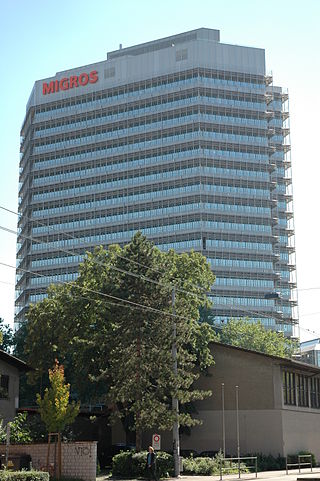
Migros is Switzerland's largest retail company, its largest supermarket chain and largest employer. It is also one of the forty largest retailers in the world. It is structured in the form of a co-operative federation, with more than two million members.

White chocolate is a confectionery typically made of sugar, milk, and cocoa butter, but no cocoa solids. It is pale ivory in color, and lacks many of the compounds found in milk, dark, and other chocolates. It is solid at room temperature because the melting point of cocoa butter, the only white cocoa bean component, is 35 °C (95 °F).

Stollwerck GmbH is a German chocolate manufacturer based in Norderstedt. It was founded in 1839 and expanded internationally in Europe and America, becoming the second largest producer of chocolate in the United States by 1900. Stollwerck was owned by Barry Callebaut from 2002 to 2011. Since October 2011 it has belonged to Belgian firm Baronie Group.

Chokito is a combination chocolate bar brand, created and owned by Nestlé. The original bar consists of an ingot-shaped caramel fudge center, with a coating of milk chocolate and crisped rice on the outside. It is manufactured by Nestlé in Switzerland, Brazil, and Australia.

Swiss chocolate is chocolate produced in Switzerland. While cacao beans and other ingredients, such as sugar cane, originate from outside Switzerland, the actual production of the chocolate must take place in Switzerland. Switzerland's chocolates have earned an international reputation for high quality with many famous international chocolate brands.

Villars Maître Chocolatier SA is a Swiss chocolate company founded in 1901 and based in the city of Fribourg. The building in which the company has been in since 1901 is one of national importance and a Swiss cultural heritage asset. The company is noted for its success in selling to tourists, owing to a number of unique products including chocolates with an unusually high percentage of nuts and almonds and 72% cocoa dark chocolate napolitains.
Delica AG, based in Birsfelden, is a business enterprise of the M-Industry and belongs to the Swiss trading group Migros. Its field of activities comprises the procurement, refinement, packaging and marketing of raw materials and commodities from around the world, with particular emphasis on coffee and non-perishable foods such as dried fruits and mushrooms, nuts and kernels, spices, as well as legumes.
Chocolats Halba is a Swiss chocolate producer based in Pratteln (Basel-Landschaft). Chocolate Halba operates its own factory shops, the so-called Schoggihüsli, in Pratteln and at the former factory in Hinwil. It is a division of the retail company Coop and processes around 20,000 tons of chocolate into bars, pralines and Easter bunnies every year. Around 40% of the chocolate is delivered to the Coop Group, the rest goes to third-party customers around the world – including those in Switzerland, Germany, France, Holland, the USA, Canada, New Zealand and China. In addition to the Coop brand Swiss Confisa, they also produce for other brands such as "Die Gute Schokolade" by Plant-for-the-Planet and for the processing industry.
Al Nassma Chocolate LLC is a manufacturer and retailer of camel milk chocolates. Founded in Dubai in 2008, the company retails its products in Dubai and in Europe, Hong Kong, and Malaysia.
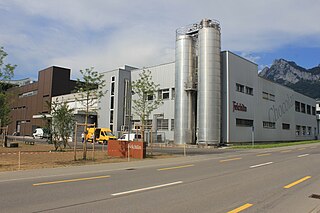
Max Felchlin AG is a company headquartered in Schwyz, Switzerland which produces chocolate and other baking and confectionery ingredients.
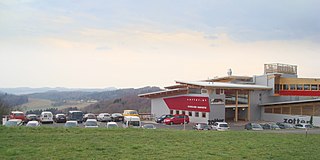
Zotter Schokolade is an Austrian chocolate manufacturer specializing in organic and fairly traded bean-to-bar chocolate. The company was founded in 1999 by Josef Zotter and is based in Riegersburg, Styria. Zotter is mostly active in German-speaking Europe, with 90 percent of distribution outlets being located in Germany, Switzerland, and Austria. As one of Austria's most well-known trademarks, Zotter is considered a national high equity brand.

Camille Bloch is a Swiss chocolate producer based in Courtelary. It was founded in 1929 in Bern by Camille Bloch, a Bernese chocolatier, then moved to Courtelary in the Bernese Jura where production has been since 1935. The family business employed 180 people and in 2016, Camille Bloch produced about 3,500 tons of chocolate, generating sales of around 60 million francs.

Kägi Söhne AG is a Swiss confectioner and chocolate producer based in Lichtensteig. The chocolate-covered wafer specialty Kägi fret from the eastern region in Switzerland, Toggenburg, are available in various flavours and are manufactured by Kägi Söhne AG, Toggenburgerwaffeln- & Biscuitfabrik.
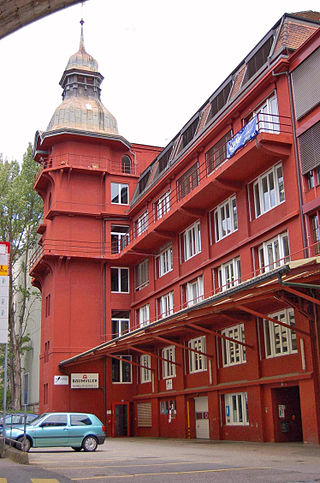
Chocolat Suchard was a chocolate factory founded in Serrières by Philippe Suchard in 1826. It was one of the oldest chocolate factories in Switzerland.

Peter's Chocolate was a Swiss chocolate producer founded in 1867 by Daniel Peter in Vevey. It is notably the company who produced the first successful milk chocolate bar. It merged with Kohler in 1904, with Cailler in 1911, and was bought by Nestlé in 1929. The brand was purchased by Cargill in 2002. Peter's Chocolate was recurrently advertised with the image of a traditionally dressed man waving a chocolate bar, often with an Alpine scenery.
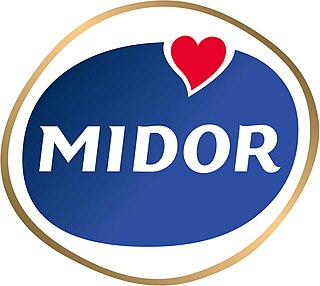
Midor AG was a company of the Swiss retail group Migros, which developed and produced biscuits, ice cream and snacks. It supplied customers in Switzerland and 19 other countries. Midor also produced numerous products for Migros brands and large corporations in Switzerland and abroad. Midor was founded in 1928 and belonged to the M-Industrie Gruppe. It employed around 600 people at its location in Meilen at Lake Zurich.







